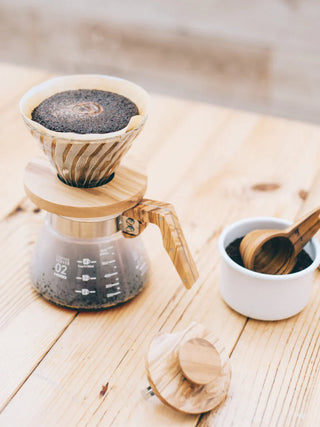All product imagery for this theme demo have been kindly provided by Eight Ounce.
Using a pour-over coffee maker involves a relatively simple but precise process to brew a flavorful cup of coffee. Here are the general steps to use a pour-over coffee maker:
Equipment You'll Need:
- Pour-over coffee maker (such as a Hario V60, Chemex, Kalita Wave, or your preferred brand/model).
- Coffee beans (whole or freshly ground).
- Filter paper (specific to your pour-over maker).
- A kettle for boiling water.
- A scale (optional but recommended for precise measurements).
- A timer.
- A mug or carafe to catch the brewed coffee.
Steps:
-
Boil Water: Start by boiling water. The ideal temperature is around 195-205°F (90-96°C). If you don't have a thermometer, let the water come to a boil, then let it sit off the heat for about 30 seconds to reach the desired temperature.
-
Rinse the Filter: Place the filter paper in the pour-over cone (or whatever holder your pour-over maker uses) and set it on top of your mug or carafe. Pour a small amount of hot water through the filter to rinse it and preheat the pour-over device. Discard the rinse water; this step helps remove any paper taste and warms the vessel.
-
Weigh and Grind Coffee: Weigh out the coffee beans based on your desired coffee-to-water ratio. A typical starting point is using 1 to 2 tablespoons of coffee grounds for every 6 ounces (180 ml) of water, but you can adjust this to your taste. Grind the coffee beans to a medium-coarse consistency, similar to sea salt.
-
Add Coffee Grounds: Place the ground coffee into the rinsed filter in the pour-over cone.
-
Bloom: Start your timer and pour a small amount of hot water (about twice the weight of the coffee) evenly over the coffee grounds. This is called the "bloom." Allow the coffee to bloom for about 30 seconds. During this time, you'll see the coffee grounds swell and release gases.
-
Start Pouring: After the bloom, begin pouring hot water in a slow, circular motion, starting in the center and moving outward. Try to maintain an even, spiraling pour, saturating all the coffee grounds. Pour until you reach your desired coffee volume, making sure to pour in intervals to control the flow rate.
-
Maintain Water Temperature: Try to keep the water level in the cone relatively constant throughout the brewing process. If the water level gets too low, it can lead to uneven extraction.
-
Finish Brewing: The total brew time will depend on the coffee and grind size, but it typically takes 2-4 minutes. Aim for a consistent, steady pour. You can adjust the grind size, coffee dose, and pour rate to achieve the desired brew time.
-
Remove and Enjoy: Once you've added the desired amount of water, the coffee will drip into your mug or carafe. Remove the pour-over cone and enjoy your freshly brewed coffee.
Remember that practice makes perfect with pour-over coffee, and you can adjust various factors (coffee dose, grind size, water temperature, and pour technique) to fine-tune the flavor to your liking. Experiment with different coffee beans and ratios to discover your preferred brew.












